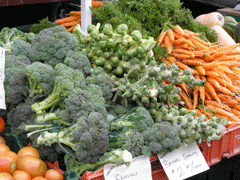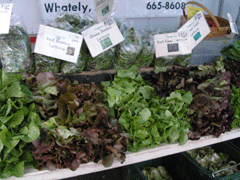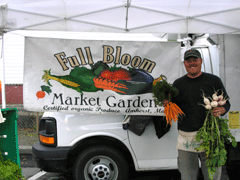Food Fright
Air Date: Week of October 20, 2006

(Photo: Emily Taylor)
America's food supply is said to be the safest in the world, but every year nearly 80 million people in the United States become ill from contaminated food and five thousand die. Living On Earth's Bruce Gellerman investigates the problem and discovers a solution that’s surprisingly close to home.
Transcript
YOUNG: Well, you don’t have to go far to find a place ripe with food safety solutions.
[FARMER’S MARKET SOUNDS]
YOUNG: Every weekday, Nathan Sigel, owner of Tempo restaurant, shops at local farmers markets in the Boston area, keeping a sharp eye out for heirloom tomatoes. He prefers them to the ones in supermarkets.
SIGEL: They have regular, you know, pale, waxy, nasty unripe tomatoes, and they are really, really expensive. These guys, you know, have got an unbelievable product and it's a lot cheaper.

(Photo: Emily Taylor)
Living on Earth's Bruce Gellerman reports.
GELLERMAN: U.S. health officials say we have the safest food system in the world. We consume vast amounts of food with no problem at all. Still, each year, nearly 80 million people in the United States suffer from a food-borne illness. Three hundred thousand are hospitalized and five thousand die from contaminated food.
ACHESON: You're right. The statistics indicate that we’ve got work to do.
GELLERMAN: Dr. David Acheson is Chief Medical Officer of the FDA's Center for Food Safety and Applied Nutrition.
ACHESON: If you turn the clock back a number of years, it was even worse. We're not there yet. We have got more work to do. But it is getting safer and safer all the time.
GELLERMAN: But it could get worse again. Much worse. A few years ago, the Pentagon conducted a classified war game called “Silent Prairie,” simulating a bioterrorist attack with the virus that causes hoof and mouth disease. Within days, the disease had spread like wildfire. Twenty million imaginary cattle had to be destroyed. Brian Halweil is a senior researcher at Worldwatch, and author of the book “Eat Here.”
HALWEIL: And when they concluded this war game, they realized that the very aspects of our food system, which make us the envy of the world, are actually the same characteristics that make us most vulnerable. And they were very frightened and surprised by their conclusions.
GELLERMAN: American agriculture is often envied for its economies of scale—the huge farms and centralized food production and distribution facilities that make our food so inexpensive. But, according to Halweil, those are the weakest links in the American food chain. He says the system puts all of our eggs in one big basket. He cites a study showing that while the typical U.S. supermarket has about 40 thousand products on the shelf, nearly half are produced by just 10 companies. And just three companies produce the majority of the nation's meat.
ACHESON: That is one of the dilemmas of large-scale farming...and we've seen this in prior years with ground beef, for example.
GELLERMAN: Again, Dr. David Acheson of the FDA.
ACHESON: Some of the large recalls of contaminated ground beef have been because a small amount of contaminated product is then mixed with a large amount of uncontaminated product, thereby resulting in a lot of contaminated product. The same concept is potentially true of, say, some of the bagged leafy greens that we've had experience of recently.

Boston leaf lettuce on sale at the local farmers’ market in Somerville, Massachusetts. (Photo: Emily Taylor)
HALWEIL: Between the Central Valley of California and the market that that lettuce ends up in, there are many opportunities along that chain for something to go wrong.
GELLERMAN: For example, says Halweil, a truck's refrigeration can break down, allowing bacteria to multiple on the produce.
HALWEIL: What's going to make us less vulnerable to these sorts of outbreaks is depending more on smaller, more diversified farms in our area. Now your small local farm isn't immune to some food safety problem, but any problem that does arise is less likely to spread to affect millions of people in dozens of states, as we've found recently in this scary spinach episode.
GELLERMAN: On this point, Dr. David Acheson of the FDA agrees.
ACHESON: If you know exactly where something's been grown and how it's been grown, those can be critical issues in insuring its safety. So it's likely to enhance your safety if you consume that product.
[FARMERS MARKET SOUNDS]
GELLERMAN: But with less than two percent of Americans involved in farming these days, the odds of knowing a farmer, especially if you live in a city, are pretty slim. But you can meet them at your local farmers market. It's where I met Chris Hartner, Farm Manager for Full Bloom Farm in western Massachusetts. There they grow 150 acres of organic produce with a watchful eye on the bottom line.

Chris Hartner shows off some of this season’s treats. (Photo: Emily Taylor)
GELLERMAN: The demand for regionally grown, organic food is soaring....sales growing at four times the rate of non-organic food. That's caught the attention of Costco and Wal-Mart which are introducing more and more organic products on their shelves. And SYSCO, the largest food distributor in North America, is also getting into the local produce business with a program it calls “Buy Local, Sell Fresh.” Craig Watson, SYSCO Vice President for Quality Assurance and Agricultural Sustainability, says as demand for locally grown produce grows, SYSCO is working with more and more small-scale farmers. It has projects in Minnesota, New Mexico and Alabama.
WATSON: We do have to help them bring their products to market to complete the supply chain because, sometimes, without making that effort, the product wouldn't get to market, or at least it wouldn't get to market on a SYSCO truck.
GELLERMAN: Locally grown produce. It's sort of back to the future to the way agriculture used to be done just a few decades ago.
For Living on Earth, I'm Bruce Gellerman.
Links
Living on Earth wants to hear from you!
Living on Earth
62 Calef Highway, Suite 212
Lee, NH 03861
Telephone: 617-287-4121
E-mail: comments@loe.org
Newsletter [Click here]
Donate to Living on Earth!
Living on Earth is an independent media program and relies entirely on contributions from listeners and institutions supporting public service. Please donate now to preserve an independent environmental voice.
NewsletterLiving on Earth offers a weekly delivery of the show's rundown to your mailbox. Sign up for our newsletter today!
 Sailors For The Sea: Be the change you want to sea.
Sailors For The Sea: Be the change you want to sea.
 The Grantham Foundation for the Protection of the Environment: Committed to protecting and improving the health of the global environment.
The Grantham Foundation for the Protection of the Environment: Committed to protecting and improving the health of the global environment.
 Contribute to Living on Earth and receive, as our gift to you, an archival print of one of Mark Seth Lender's extraordinary wildlife photographs. Follow the link to see Mark's current collection of photographs.
Contribute to Living on Earth and receive, as our gift to you, an archival print of one of Mark Seth Lender's extraordinary wildlife photographs. Follow the link to see Mark's current collection of photographs.
 Buy a signed copy of Mark Seth Lender's book Smeagull the Seagull & support Living on Earth
Buy a signed copy of Mark Seth Lender's book Smeagull the Seagull & support Living on Earth

